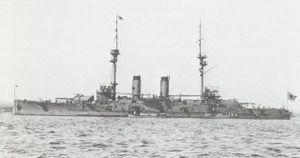 Kashima at anchor
| |
| History | |
|---|---|
| Name | Kashima |
| Namesake | Kashima Shrine |
| Ordered | 1904 |
| Builder | Armstrong Whitworth, Elswick |
| Yard number | 755 |
| Laid down | 29 February 1904 |
| Launched | 22 March 1905 |
| Completed | 23 May 1906 |
| Out of service | April 1922 |
| Stricken | 20 September 1923 |
| Fate | Scrapped, 1924 |
| General characteristics | |
| Class and type | Katori-class semi-dreadnought battleship |
| Displacement | 16,383 long tons (16,646 t) (normal) |
| Length | 473 ft 7 in (144.3 m) |
| Beam | 78 ft 2 in (23.8 m) |
| Draught | 26 ft 4 in (8.03 m) |
| Installed power |
|
| Propulsion | 2 shafts; 2 triple-expansion steam engines |
| Speed | 18 knots (33 km/h; 21 mph) |
| Range | 12,000 nmi (22,000 km; 14,000 mi) at 11 knots (20 km/h; 13 mph) |
| Complement | 864 |
| Armament |
|
| Armour |
|
Kashima (鹿島 (戦艦), Kashima (senkan)) was the second ship of the two Katori-class pre-dreadnought battleships built for the Imperial Japanese Navy (IJN) in the first decade of the 20th century, the last to be built by British shipyards. Ordered just before the start of the Russo-Japanese War of 1904–1905, the ship was completed a year after its end. She saw no combat during World War I, although the ship was present when Japan joined the Siberian Intervention in 1918. Kashima was disarmed and scrapped in 1923–1924 in accordance with the terms of the Washington Naval Treaty of 1922.